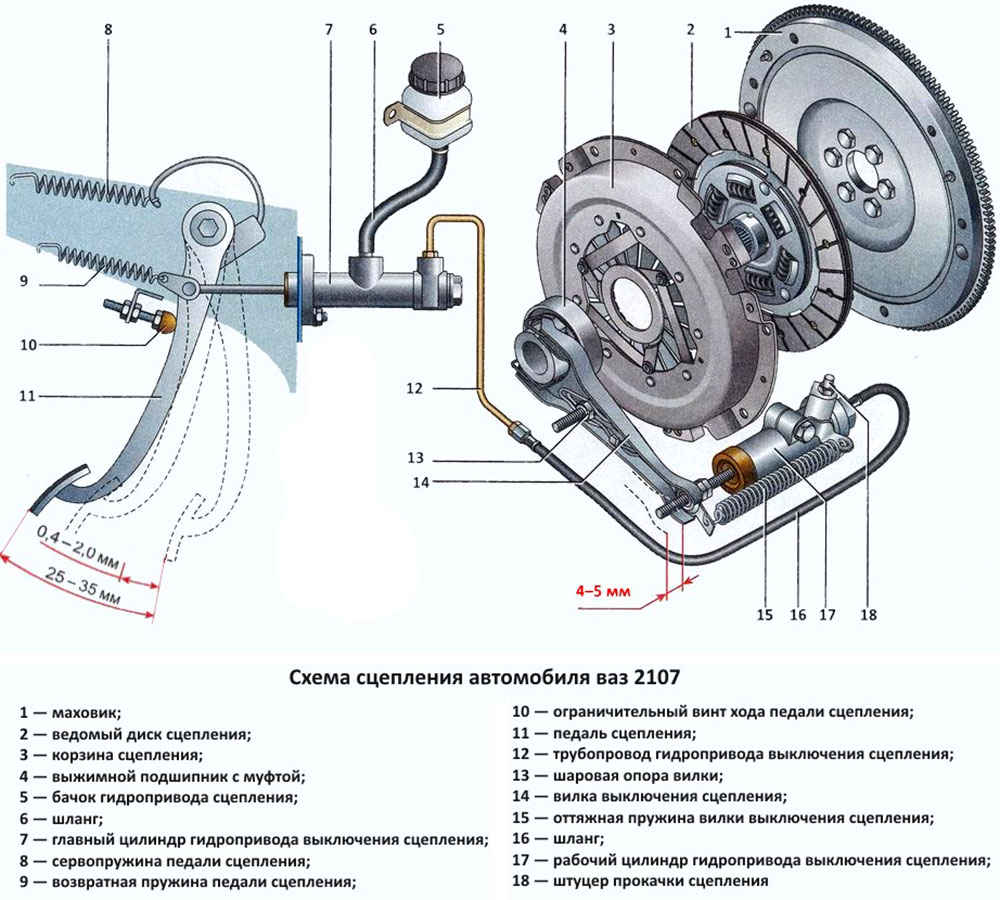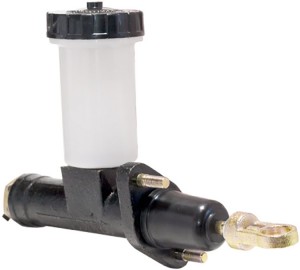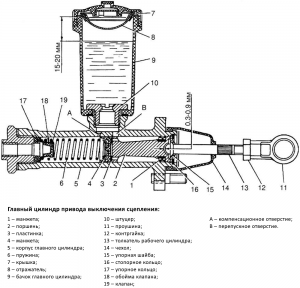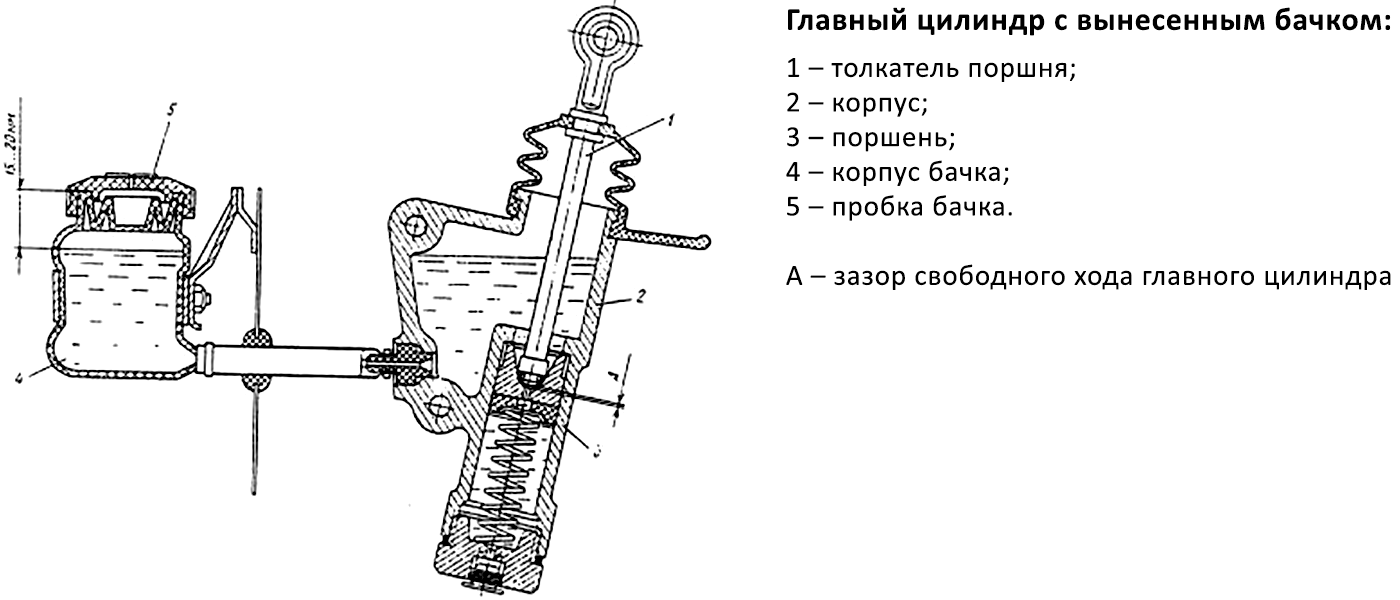
Many modern cars, especially trucks, are equipped with a hydraulic clutch release actuator. A sufficient supply of fluid for the operation of the clutch master cylinder is stored in a special tank. Read all about GVC tanks, their types and design, as well as the selection and replacement of these parts, in the article.
Purpose and functions of the GCS tank
The GCS reservoir (clutch master cylinder reservoir, GCS compensation tank) is a component of the hydraulic clutch release drive of wheeled vehicles; A plastic container in which a sufficient amount of working fluid is placed for the operation of the hydraulic drive.
Disengaging the clutch in cars with a manual transmission (with manual transmission) requires the driver to apply some muscular effort, and the larger and more powerful the car, the higher the effort has to be applied to the pedal. To facilitate the driver's work, most modern cars of all classes (both cars and trucks) have a hydraulic clutch release drive. In the simplest case, it consists of the main (GCS) and working clutch cylinders connected by a pipeline, the first of which is connected to the pedal, and the second to the clutch release fork. In heavy vehicles, the GCC can be connected to a vacuum or pneumatic amplifier. To store the supply of fluid, the reservoir of the master brake cylinder can be used, but more often an additional element is introduced into the system - the clutch master cylinder reservoir.

Hydraulic clutch drive of a passenger car
The GCC tank has several main functions:
● Storage of the fluid supply necessary for the operation of the hydraulic drive;
● Compensation for thermal expansion of the fluid;
● Compensation for minor fluid leaks from the system;
● Equalization of pressure in the tank and atmosphere (outside air intake, high pressure relief);
● Protection against liquid spillage in transient modes of operation of the hydraulic drive.
The GCC tank is one of the critical elements, without which the long-term operation of the car is difficult or even impossible, therefore, in case of any damage, it must be replaced as soon as possible. To confidently replace the clutch master cylinder tank, you should understand the design and features of this part.
Types and design of GCS tanks
The tanks used in hydraulic clutch release actuators are divided into two groups according to the installation site:
● Directly to the GVC;
● Separate from GVCs.
Tanks of various types have a number of design differences.
Design and features of tanks at the GCS
Tanks of this type are made of plastic, parts are divided into two types:
● With installation on the top of the cylinder body;
● With installation on the end of the cylinder.
In the first case, the container has a cylindrical, conical or complex shape, its lower part does not have a bottom, or the bottom is a collar of small width. In the upper part of the tank, a cork thread is formed. The plug itself in the upper part has a hole to equalize the pressure in the tank. At the bottom of the plug there is a reflector - a rubber or plastic corrugated part (or a part in the form of glasses inserted into each other), which prevents the working fluid from flowing out through the hole during sudden changes in pressure in the GCS and while driving on road bumps. The reflector additionally performs the functions of a plug gasket. Also, a strainer can be located under the lid to prevent large contaminants from entering the system when pouring liquid.

Clutch master cylinder with installed reservoir

The design of the GVC with an integrated tank
he tank is installed on the GCS through the bypass fitting, while two types of installation are possible:
● Outdoor installation with fixation with a bandage (clamp);
● Internal mounting with clamping with a threaded fitting or a separate screw.
The first method is used to install the tanks on the upper part and on the end of the GCS, the second - only on the upper part of the cylinder body. At the same time, tanks mounted on the upper part of the GCS housing are used only when the cylinder is installed horizontally, and end mounting can be used on the DCS with any inclination.
For outdoor installation, the tank with its lower part is put on the corresponding protrusion or end of the GVC, and is fixed with a bandage, a tight fit is provided by a tightening bolt. Usually, one or two rubber ring gaskets are placed under the sealing tank.
For internal installation, the tank with its lower part is installed on the corresponding protrusion on the cylinder body (through the gasket), and a fitting with a wide collar is screwed inside - due to the collar, the tank is pressed against the GCS body and firmly fixed on it.
As a rule, the reservoir is held on the cylinder body only by a bandage or bypass fitting, but sometimes additional fixation with two screws and brackets is used.
Design and features of tanks separate from the GVC
Tanks of this type are one-piece plastic (made by extrusion) or assembled from two cast halves. In the upper part, a filler neck is formed for a threaded plug, and on the bottom or on the side wall at the bottom - one fitting. The tanks use plugs similar to those described above. The tank is mounted on the body parts or the frame of the vehicle (using brackets) separately from the GVC, the supply of working fluid is carried out using a flexible hose fixed to the fittings with clamps.

GCS with remote tank
Separately installed tanks are divided into two groups:
● Connected to the DCS through a bypass fitting;
● Connected to the GCC through a conventional fitting.
The connection of the first type is used in hydraulic drives with GCS without an integrated container for liquid. The fitting has two holes of different cross-sections - bypass and compensation, through which oil flows from the reservoir to the GCS and vice versa, depending on the operating mode of the clutch drive.
The connection of the second type is used in hydraulic drives, in which the GVC has an integrated container for the liquid - similar systems can be found on many MAZ, KAMAZ vehicles and other trucks. In such systems, the tank is only a compensation tank from which oil enters the main tank, or excess oil from the main tank flows into the tank (when heated, pressure increases). The tank is connected to the GCS through a conventional fitting with one hole.
Separately installed tanks can be used in conjunction with GVCs that have any spatial position - horizontal or inclined. This design allows you to place hydraulic drive components in convenient areas, but the presence of a hose somewhat reduces the reliability of the system and increases its cost. Individual tanks are widely used on vehicles of all types and classes.
Selection and replacement of the GCC tank
The parts considered here are made of plastic, which is susceptible to aging and can be damaged during operation, which requires repair. Usually, repairs are reduced to replacing the tank or tank along with the plug and related parts (hose, clamps, etc.). Only those types of components (catalog numbers) that are installed on the car from the factory should be taken for replacement, especially for tanks mounted on the GCS body (since they have landing holes of different shapes and cross-sections). Repair work is carried out in accordance with the instructions for repair and maintenance of the vehicle.
Usually, the order of work is as follows:
1.Drain the working fluid, or empty the tank with a syringe / bulb);
2.Tank with fitting - loosen the clamp and remove the hose;
3.Tank on the GCS - loosen the bandage or unscrew the fitting;
4.Check all mating parts, remove old gaskets and hose if necessary;
5.Perform the installation of new parts in reverse order.
After the repair, it is necessary to fill the tank with the working fluid provided for the car and bleed the system to remove air. In the future, with each maintenance of the hydraulic clutch release, it is only necessary to check the reservoir and its plug. With the right parts and repairs, the clutch reservoir will work reliably, providing comfortable and safe driving.
Post time: Jul-11-2023
